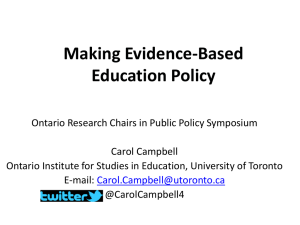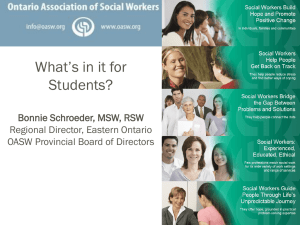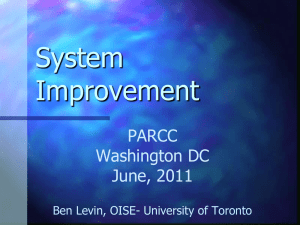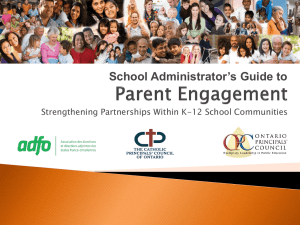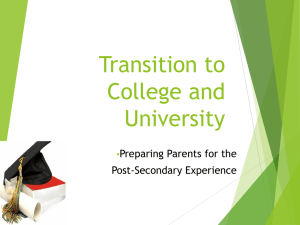A Student`s Voice - Ny Nordisk Skole
advertisement
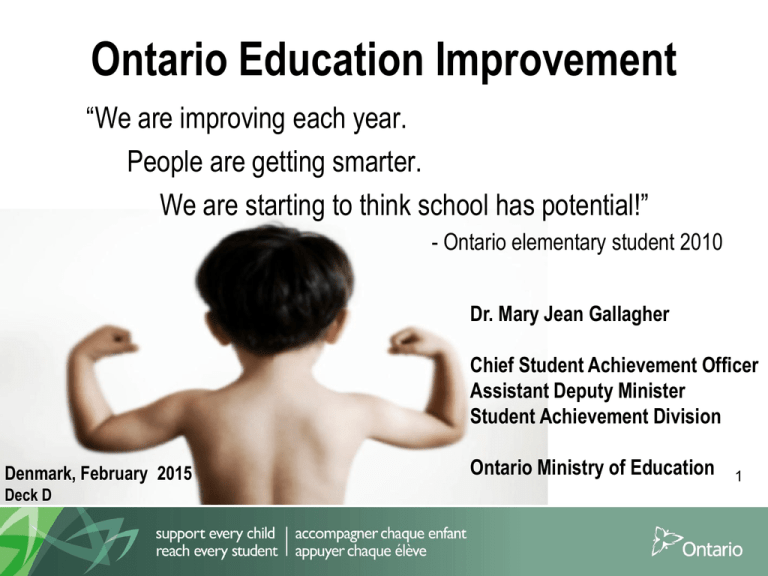
Ontario Education Improvement “We are improving each year. People are getting smarter. We are starting to think school has potential!” - Ontario elementary student 2010 Dr. Mary Jean Gallagher Chief Student Achievement Officer Assistant Deputy Minister Student Achievement Division Denmark, February 2015 Deck D Ontario Ministry of Education 1 A Student’s Voice: “Education is not just about gaining knowledge from a textbook but taking action by applying our knowledge to make an impact.” - Ontario secondary student, Minister’s Student Advisory Council Representative, 2014 2 Snapshot – Province of Ontario Ontario has: • 40% of Canada’s 33.6 million people (it is the most populous province) • In 2013, Ontario received 40.0% (103,402) of permanent resident admissions to Canada (258,619) • Over 1 million square kilometres of land • 2.1 million students • English is not the first language of many of our students • Almost 126,000 teachers (unionized teaching and support staff) • About 5,000 schools in 72 school districts • Operational Funding of $22.53B (CDN) in 2014-15 3 Our Vision: Achieving Excellence • Learners…will develop the knowledge, skills and characteristics that will lead them to become personally successful, economically productive and actively engaged citizens • Development of a high-quality teaching profession and strong leadership at all levels of the system • High expectations and success for all • Responsive, high quality, accessible and integrated from early learning and child care to adult education 4 Ontario’s Renewed Goals for Education • Achieving Excellence: Children and students of all ages will achieve high levels of academic performance, acquire valuable skills, and demonstrate good citizenship. Educators will be supported in learning continuously and will be recognized as among the best in the world. • Ensuring Equity: All children and students will be inspired to reach their full potential, with access to rich learning experiences that begin at birth and continue into adulthood. • Promoting Well-Being: All children and students will develop enhanced mental and physical health, a positive sense of self and belonging, and the skills to make positive choices. • Enhancing Public Confidence: Ontarians will continue to have confidence in a publicly funded education system that helps develop new generations of confident, capable, and caring citizens. 5 Signs of Signs of Success success 6 Elementary Outcomes: Achievement Results Over 170,000 more students at provincial standard 4 key levers for elementary reform: 1. Improving classroom teaching and learning 2. Improving school effectiveness 3. Leadership capacity building 4. Research and evaluation 7 Secondary Outcomes: Achievement Results Provincial Graduation Rate 6 key levers for secondary reform: 1. Leadership infrastructure 2. Engaging and relevant programming 3. Effective instruction 4. Focused Interventions for students at risk of not graduating 5. Legislation and policy development 6. Research, monitoring and 8 evaluation Capacity Building: Lessons from Ontario Ontario’s strong PISA results would suggest that this emphasis on building the critical thinking and problem-solving skills of teachers has strengthened the capacity of teachers to enable the development of these same kinds of skills in their students. From OECD Report: Strong Performers and Successful Reformers in Education: Lessons from PISA for Japan – 2011 Today, Ontario’s publicly funded education system – acknowledged as one of the best in the world – partners with parents, guardians and communities to develop graduates who are personally successful, economically productive and actively engaged citizens. From Achieving Excellence, 2014 (Ontario Ministry of Education) 9 How We’ve Done It… 10 Levers to Successful Improvement Systems 1. 2. 3. 4. 5. 6. 7. 8. A small number of ambitious goals Leadership at all levels High standards and expectations Investment in leadership and capacity building related to instruction Mobilizing data and effective practices as a strategy for improvement Intervention in a non-punitive manner Reducing distractions Being transparent, relentless and increasingly challenging 11 1. A Small Number of Ambitious Goals Ontario’s New Education Vision, 2014 • Achieve excellence - High levels of student achievement, professional excellence – 75% of students with high level of literacy and numeracy skill by age 12 – 85% of students graduating from high school within 5 years of starting – Students who are personally successful, economically productive, actively engaged citizens • Ensure equity - reduced gaps in student achievement • Promote Student Well-Being • Enhanced public confidence in education 12 2. Leadership at All Levels A guiding coalition at the top: • Premier • Minister of Education • Deputy Minister • Chief Student Achievement Officer Distributed leadership with a focus on teaching and learning: • School Districts • School Principals • Teachers 13 3. High Standards and Expectations • • • • Standards based curriculum Transparent standard of performance Independent assessments of student achievement Provincial standards of literacy and numeracy require creative thinking, problem solving, higher order thinking skills 14 4. Leadership and Capacity Building Related to Instruction – Focus, Alignment and Coherence 15 4. Leadership and Capacity Building Related to Instruction – School Improvement Planning As An Engagement Tool Goals Targeted, EvidenceBased Strategies Needs Assessment • • • • • Resources Student achievement data Demographic data Program data Perceptual data Analysis of data Professional Learning Evaluation Monitoring16 Responsibility 4. Leadership and Capacity Building Related to Instruction – K - 6 Literacy and Numeracy Improving classroom teaching and learning – Collaborative inquiry – Tutoring – Resources: monographs, DVDs, online supports – Direct program supports – Research – Supports for teacher professional learning Improving School Effectiveness – Targeted interventions – Student voice – Parent engagement – Planning tools and processes – Networking schools – Collaborative professionalism Leadership Capacity Building – Ontario Leadership Framework – School Effectiveness Leads – Student Achievement Officers – Supports for principal professional learning 17 4. Leadership and Capacity Building Related to Instruction – 7 - 12 Student Success School culture and the four pathways – Student Success Leads, teachers and teams – Student Success Education Officers – Career/life planning for all students – Parent engagement Interventions for students at risk of not graduating – Credit recovery – Caring adult – Re-engagement in high school Engaging and relevant programming – Experiential and co-operative learning (e.g., SHSM) – Student voice – Alternative, adult and continuing education Effective instruction – Differentiated instruction – Professional learning cycle – Literacy and mathematics professional learning4 18 Engaging and Relevant Programming: Experiential Education • Experiential learning is any activity in which students learn from an authentic, hands on experience, reflect on the learning, and then apply that learning to new situations. • Types of experiential learning may include the following: – Educational programs linking to work and career – applying curriculum and skills from the classroom in a ‘real world’ practical context – Volunteer experience – engaging in activities in the community to develop new skills, and applying those skills to new contexts opportunities/experiences – Project-based, cross curricular learning – approaching a project/task from a mutli-disciplinary perspective and integrating a variety of sources and contexts – Student voice, student inquiry – identifying and engaging in experiential learning opportunities that are student-directed/ selected, and reflecting on these 19 Specialist High Skills Majors (SHSM) “…students enrolled in SHSM programs appear to improve their performance in terms of average course marks and rates of credit accumulation compared to those not enrolled; the SHSM programs are attracting higher proportions of males, students with a special education classification, and students from applied (college or workplace) streams compared to the general student population.” (Research funded by the Higher Education Quality Council of Ontario) 20 Dual Credit Programs • • Dual Credit programs allow students while still at secondary school to take college or apprenticeship courses that count towards both their OSSD and post-secondary certificate, diploma, degree or apprenticeship certificate of qualification. All seventy school boards that have secondary schools and all 24 Ontario colleges of applied arts and technology are involved in providing secondary school students with dual credit learning opportunities. 2005-06 2006-07 2007-08 2008-09 2009-10 2010-11 2011-12 2012-13* 361 2,500 4,300 4,500 7,500 12,800 16,000 17,500 Dual Credit Funding Only $1M $4M $8M $8M $17M $25M $32M $32M SCWI Funding in Total $3M $7M $12M $19M $27M $30M $37M Student Enrolment * Projected numbers $36M 2013-14* 2014-15* 21,000 21,400 $32M $32M $36M $36M 21 5. Mobilizing Data and Effective Practices As a Strategy For Improvement Provincial Results for Junior Writing (English-Language) 100 • Building a data system 90 – Assessments – Tracking data 70 87 80 60 50 78 75 70 64 60 Girls 54 46 • Precise Teaching to meet students’ needs 40 44 All 46 Boys SpecEd ESL/ELL 30 First Nations 24 20 10 12 0 22 5. Mobilizing Data and Effective Practices As a Strategy For Improvement • Building on evidence-based culture • Research Practice 24 5. Mobilizing Data and Effective Practices As a Strategy For Improvement Our Shared Beliefs: • All students can succeed. • Each student has his or her own unique patterns of learning. • Successful instructional practices are founded on evidence-based research, tempered by experience. • Universal design and differentiated instruction are effective and interconnected means of meeting the learning or productivity needs of any group of students. • Classroom teachers are the key educators for a student’s literacy and numeracy development. • Classroom teachers need the support of the larger community to create a learning environment that supports all students. • Fairness is not sameness. - From Learning For All: A Guide to Effective Assessment and Instruction for All Students,24 Kindergarten to Grade 12 (2010), Ontario Ministry of Education 5. Mobilizing Data and Effective Practices As a Strategy For Improvement - From Learning For All: A Guide to Effective Assessment and Instruction for All Students, 25 Kindergarten to Grade 12 (2010), Ontario Ministry of Education 5. Mobilizing Data and Effective Practices As a Strategy For Improvement - From Learning For All: A Guide to Effective Assessment and Instruction for All Students, 26 Kindergarten to Grade 12 (2010), Ontario Ministry of Education 6. Intervention in a Non-Punitive Manner Ontario Focused Intervention Partnership (OFIP) What: • • • • 2003-04: 760 schools with <33% of students at levels 3 & 4 2012-13: 87 schools with <50% of students at levels 3 & 4 for two consecutive years 2013-14: 69 schools with <50% of students at levels 3 & 4 for two consecutive years 2014-15: 63 schools with <50% of students at levels 3 & 4 for two consecutive years How: • • • • • Intervention strategies based on needs identified at school level Completion of an action plan, including requested LNS support Participation of principal & Supervisory Officer in learning opportunities Participation in school-based professional learning communities Participation of the school teams in formal and informal networked learning opportunities. 27 6. Intervention in a Non-Punitive Manner Student Success School Support Initiative (SSI) What: • SSI is a strategic intervention that provides differentiated support to schools where student performance in Grade 9 and 10 applied classes is below the provincial rate and students are therefore not on target to graduate in 4 or 5 years Result: • Improved student achievement in a majority of participating schools • Enhanced principal instructional leadership capacity • Enhanced learning and teaching practices How: • Strategic and targeted professional learning sessions for principals and professional learning teams • Focus on tracking and monitoring student achievement data • Focus on student intellectual engagement in their learning 28 7. Supporting Conditions and Reducing Distractions • Aboriginal Education • Ontario Leadership Strategy • Safe Schools & Anti Bullying • Governance Legislation • Healthy Schools • Research Strategy • Community Use of Schools • Equity Policy and Initiatives • Anti Poverty Agenda • Mental Health Strategy • Full day Kindergarten • Promoting Well-Being • Negotiations and collective agreements 29 8. Being Transparent, Relentless and Increasingly Challenging • All children and students can learn • A sense of urgency • Sustaining and extending our reforms 30 Thank you! For further information contact: Mary Jean Gallagher 1-416-325-9964 maryjean.gallagher@ontario.ca Or contact executive assistant: Josie Vite 1-416-327-5317 josie.vite@ontario.ca 31
